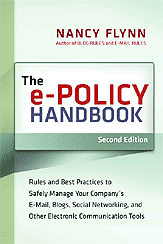- Write a Subject Line with OOMPH.
A small but powerful weapon
in the battle to capture reader attention, the subject line should reveal
what the eMessage is about before it's opened.
Attracting and Retaining Top Performers, for example, says more than
Employee Benefits.
- Never Begin with Thank You.
You only have a few seconds to grab the reader's attention. Start strong. Make your point in the first few words of your eMail, then repeat, rephrase, and reiterate.
- Write as Though Mom Were Reading.
Don't write anything you wouldn't feel comfortable saying in an elevator crowded with customers, colleagues, and competitors. An inaccurate keystroke or the recipient's decision to forward your message could land it on thousands of unintended readers' screens.
- Obey the Rules of Netiquette.
No shouting. No flaming. No spamming. Translation: Don't write in capital letters. Don't send hostile messages. Don't forward electronic junk mail.
- Remain Gender Neutral.
Your intended reader may be male, but the ultimate decision-maker could be a woman. Avoid masculine pronouns and other "turn-off" language.
- Inquire About Attachments.
Some companies prohibit the opening of attachments. Always ask if the recipient would prefer receiving material as an attachment or as part of the eLetter itself.
- Resist the Urge to CAPITALIZE!!!
The eye is accustomed to reading a mix of upper and lowercase letters, so stick with standard style. Don't slap exclamation points on the end of sentences!!! Instead, pump up your writing with descriptive language and well-crafted sentences.
- Don't Use eMail to Deliver Bad News.
Without the benefit of body language, facial expressions, or intonation, eMail is no way to deliver bad news. Meet or use the phone to notify a customer of production delays, reject a prospect's credit application, or fire an employee.
- Acknowledge eMail's Limitations.
eMail is the best way to deliver news fast, but it's not the best route to a quick reply. Your reader is under no obligation to check in-coming messages regularly, if at all. For an immediate reply to a pressing issue, opt for a phone call or meeting.





